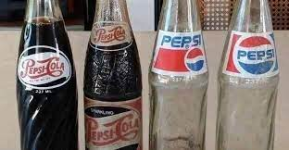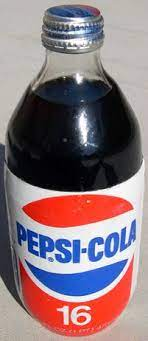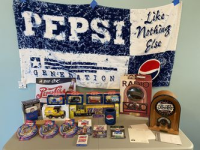
Do you remember the 90s and early 2000s? A time when grunge ruled the airwaves, dial-up internet was the norm, and boy bands were taking over the world. Amidst this cultural whirlwind, there was another iconic figure that reigned supreme: Pepsi. In this trip down memory lane, we're diving deep into the 90s Pepsi revolution, exploring how this fizzy beverage became synonymous with an entire generation's nostalgia.
As a fervent fan of all types of sodas, I must confess that Pepsi held a special place in my heart. While it might not have been the most popular choice among my peers during the 90s, I had an undeniable soft spot for it.
In the mid-90s, the world of soda was dominated by a select few players. Pepsi, Coca-Cola, and Dr. Pepper all fought for the lion’s share of the market, but Pepsi was ultimately the most successful. Their aggressive marketing strategy was unmatched, and their innovative products gave consumers a wide variety of choices. While other companies played it safe, Pepsi took chances with creative drinks and exclusive partnerships.
The 90s Soda Landscape
To understand the significance of Pepsi in the 90s, we must first set the stage. The soda landscape of this era was fiercely competitive, with cola giants like Coca-Cola vying for the top spot. It was the era of the "cola wars," and Pepsi was determined to make its mark.

Pepsi was more than just a beverage; it was a cultural phenomenon. The 90s marked a turning point when soda wasn't just about quenching your thirst—it was about expressing your identity. And Pepsi was at the forefront of this transformation.
At the same time, new product lines and flavors were introduced. Pepsi Fire, Pepsi Blue, and Pepsi back in the Mix were just a few of the offerings, each using unique visuals and taste combinations to stand out among the competition. Mountain Dew Code Red was another hit, as was the ever-popular Surge. Consumers were spoiled for choices, and each soft drink offered its own unique experience.
- Pepsi was the most successful soda company in the 90s, thanks to their aggressive marketing and innovative products.
- New product lines and flavors were introduced, such as Pepsi Fire, Pepsi Blue, and Mountain Dew Code Red.
- Consumers had a wide variety of choices when it came to soft drinks – each offering its own unique experience.
- Exclusive partnerships between companies allowed for even more creative drinks like Surge and Pepsi back in the Mix.
Pepsi began its journey in 1893 when North Carolina-based pharmacist Caleb Bradham invented the soft drink. Bradham developed the Pepsi formula out of kola nut extract and both vanilla and sugar. In 1902, Bradham renamed the drink "Pepsi-Cola," and it quickly grew in popularity. Later, in 1931, the first Pepsi slogan was introduced with the catchy phrase "It's the Cola," paired with its signature swirly font.
 Over the next two decades, Pepsi expanded its reach internationally. In 1960, the Pepsi Product Service division launched; this was the first time the company employed the use of vending machines in retail locations. The company also released its iconic "Pepsi Generation" slogan in 1963, which aimed to target an audience of young and progressive individuals. By 1994, Pepsi was one of the top most recognized brands in the world.
Over the next two decades, Pepsi expanded its reach internationally. In 1960, the Pepsi Product Service division launched; this was the first time the company employed the use of vending machines in retail locations. The company also released its iconic "Pepsi Generation" slogan in 1963, which aimed to target an audience of young and progressive individuals. By 1994, Pepsi was one of the top most recognized brands in the world.Pepsi's Bold Innovations
One of the hallmarks of the 90s Pepsi revolution was its bold innovations. Pepsi wasn't content with sticking to the traditional cola formula. It ventured into uncharted territory, giving birth to iconic flavors like Crystal Pepsi and Pepsi Blue.
Crystal Pepsi, a clear cola, was a marketing marvel. It captured the essence of the 90s obsession with transparency and purity. Its sleek, transparent bottle was a sight to behold, and it sparked curiosity among consumers. This innovative drink became a symbol of the era's adventurous spirit.
Pepsi Blue, on the other hand, embraced the vibrant aesthetics of the 90s. With its electric blue hue and bold, fruity flavor, it appealed to a younger audience, perfectly aligning with the youthful spirit of the decade.
Throughout its long history, Pepsi has been a fearless leader in the beverage industry, consistently pushing the boundaries of innovation. One of its most groundbreaking initiatives occurred in the mid 1960s when the company launched the now iconic jingle "Pepsi Generation," positioning Pepsi as the "choice of a new generation." This call to action jumpstarted an era of tastemaker marketing, shifting the focus from traditional ads to viral internet campaigns that endorsed Pepsi as the product of trendsetting choice.
The company also sought to engage a wide range of customers by releasing limited edition flavors and designs exclusive to certain countries. Through this strategy, Pepsi aimed to capitalize on regional trends and become the go-to beverage for people who crave a burst of flavor and nostalgic fun. This push for international ubiquity solidified Pepsi's place in the industry and put it firmly on the map as an innovator and disruptor.
The Pepsi Generation
As we unpack the 90s Pepsi revolution, it's impossible to ignore the emotional connection people had with this brand. Pepsi wasn't just fa drink; it was a cultural signifier. It was the beverage of choice for a generation seeking excitement and change.

I vividly remember the excitement of sipping on a Crystal Pepsi while watching my favorite 90s cartoons. The taste was unique, but it was the sense of being part of something new and exciting that made it special.
Pepsi's advertising campaigns struck a chord with consumers. From the iconic "Pepsi Generation" slogan to celebrity endorsements featuring the likes of Michael Jackson and Cindy Crawford, Pepsi was everywhere. It wasn't just about refreshment; it was about lifestyle and aspiration.
Pepsi was determined to contain its place in the beverage industry by capitalizing on its growing fame and fan base. In 1963, the "Pepsi Generation" was born, a massive campaign to target the growing population of young adults. The campaign used creative tactics such as celebrity endorsements, non-traditional advertising techniques, and even product placement in films and television series. Pepsi believed if they could successfully engage with the younger age group, they would have a strong foundation to remain a top beverage brand of choice.
The first major celebrity endorsement for Pepsi was none other than Michael Jackson, who famously starred in a series of commercials and print advertisements in 1983. This quickly endeared him to the Millennials and Generation Xers, but that was only the beginning. Pepsi consistently pushed the envelope with bold and popular campaigns that engaged with their target audience.
From Britney Spears and N*SYNC to the Spice Girls and Beyonce, Pepsi always had a lineup of stars and groups that got the attention of its fans. The product placement in films and Sunday night television set an even higher bar for lasting presence in the minds of the consumers and fans who loved their products.
Unforgettable Nostalgic Commercials
No exploration of 90s Pepsi would be complete without a journey through its memorable commercials. These ads weren't just advertisements; they were cultural touchstones.
Watching those commercials with Michael Jackson and the electrifying dance moves made me want to grab a Pepsi and dance along. Pepsi also gave us unforgettable jingles and slogans that still echo in our minds. "Pepsi, the Choice of a New Generation" became an anthem for a youthful, optimistic era.
In the 1990s, Pepsi ran a flurry of commercials that became ingrained in the popular culture of the age. From the iconic Cindy Crawford ad to the Britney Spears “Joy of Cola” commercial, Pepsi worked together with a diverse range of entertainers to produce advertisements that connected with their target audience.
The Cindy Crawford commercial is widely considered to be the most iconic commercial of its time. The advertisement showcases Crawford standing atop of a red car, a Pepsi can in each of her hands, while children chase after her to get a can of their own. This commercial defined an entire generation of people, displaying what it means to be young, bold and determined to be alive.
Pepsi Collectibles and Promotions
Beyond the liquid refreshment, Pepsi offered a treasure trove of collectibles and promotions. The brand knew how to engage with its audience beyond the soda aisle.

Remember those Pepsi cans featuring your favorite sports teams or movie characters? Collecting these cans became a hobby for many, and they are now prized possessions for collectors and enthusiasts.
Pepsi promotions were equally exciting. Who can forget the "Pepsi Points" promotion, where you could redeem points for exclusive merchandise? It was a game-changer, fostering brand loyalty and excitement.
Pepsi has a long history of offering a variety of promotions, giveaways, and collectible items to its fans. From 1990 to 2000, Pepsi merchandise had a distinct retro vibe to it, with vintage-looking bottles, caps, straws, stickers, patches, apparel, and more. Pepsi also held annual promotional contests consisting of prizes such as cars, cash, airplane tickets, and beach trips. Fans frequently showed their loyalty with coveted Pepsi shirts, cups, and accessories.

One of the most famous promotional campaigns was the Pepsi Stuff launch in 1996. Customers could collect points off special-edition Pepsi products and redeem their points for items from the Pepsi Stuff catalog. The catalog featured a diverse range of items, from clothing and video games to skateboards and digital cameras. The iconic promotion ran for almost 18 years and Pepsi Stuff remained highly sought-after until the company's last catalog in 2014.
The Pepsi Revolution's Legacy
As we wrap up our journey through the 90s Pepsi revolution, it's essential to recognize its lasting impact. Pepsi wasn't just a soda; it was a cultural phenomenon that shaped an entire generation's memories.
Pepsi's bold i
 nnovations and marketing strategies continue to influence the beverage industry today. The spirit of adventure and reinvention that defined Pepsi in the 90s is still alive in its new product launches and campaigns.
nnovations and marketing strategies continue to influence the beverage industry today. The spirit of adventure and reinvention that defined Pepsi in the 90s is still alive in its new product launches and campaigns.Pepsi has come a long way since its original release in 1898. What began as a humble yet bold experiment for Pepsi Co. has become a timeless legacy in the history of soft drinks. Deserving of its ‘Pepsi Generation’ moniker, the brand has maintained a loyal consumer base for more than a century. Its impact on the soda landscape in the 1990s saw a revitalization of its appeal with a generation of new fans introduced to the classic taste in new and creative ways.
Not only does Pepsi foster a loyal consumer base, it has played a key role in marketing innovation. Its memorable commercials and collections of Pepsi-themed products have become a part of popular culture and remain relevant. The Pepsi Revolution's legacy lives on today in its continued commitment to pushing the boundaries of marketing, product development, and customer experience while remaining true to its core values.
Final Thoughts
In the grand tapestry of 90s pop culture, Pepsi holds a special place. It wasn't just a beverage; it was a symbol of the times—a symbol of innovation, youthfulness, and unbridled optimism. Whether you were sipping on Crystal Pepsi while watching your favorite TV show or collecting Pepsi Points for exclusive gear, Pepsi was there, shaping memories and creating a sense of belonging to the Pepsi Generation.
So, as we look back at the 90s Pepsi revolution, let's raise a glass (or a can) to the fizzy drink that defined an era—a drink that still evokes a sense of nostalgia and reminds us of the joy of being part of a cultural phenomenon. Here's to the good old days and the sweet taste of Pepsi in the 90s!

